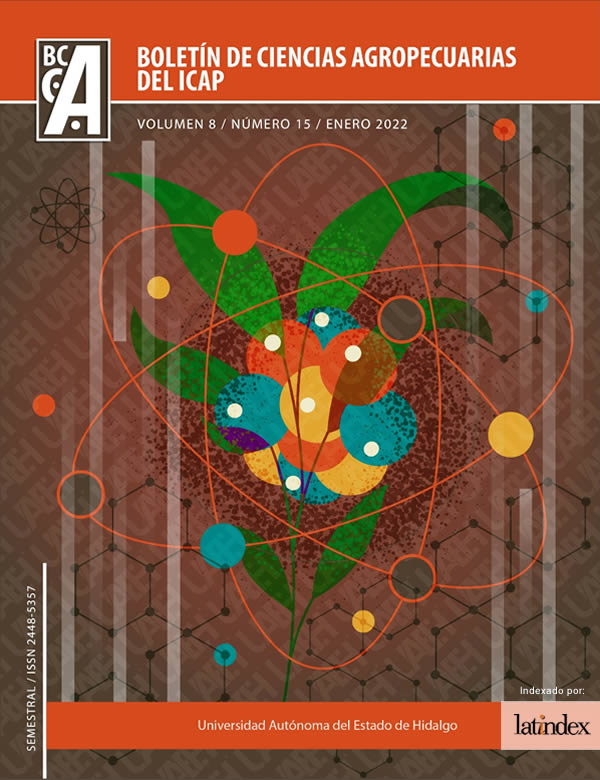Argemone mexicana contains secondary metabolites that control phytopathogenic fungi
Abstract
Plant diseases caused by phytopathogenic fungi limit crop production worldwide. Until now, the main control method has been synthetic fungicides, but their uncontrolled use causes severe health and environmental problems. Environmentally friendly alternatives are currently being sought; Biofungides made from plant extracts are a promising alternative for the control of phytopathogens. Some extracts obtained from Argemone mexicana contain secondary metabolites such as: alkaloids, terpenoids, flavonoids and phenolic compounds, among others, which report biological activity against fungi that infect crops of commercial interest.
Downloads
References
Martínez-Ruiz FE, Cervantes-Díaz L, Aíl-Catzím CE, Hernández-Montiel LG, Sánchez CL y Rueda-Puente EO. Hongos fitopatógenos asociados al tomate (Solanum Lycopersicum L.) en la Zona Árida del noroeste De México: la importancia de su diagnóstico. European Scientific Journal. 2016; 12(18): 232-256.
Cantrell CL, Dayan FE y Duke SO. Natural products as sources for new pesticides. Journal of natural products. 2012; 75(6): 1231-1242.
Koul O, Walia S y Dhaliwal GS. Essential oils as green pesticides: potential and constraints. Biopesticides international. 2008; 4(1): 63-84.
Mesa AM, Marin PA, Ocampo O, Calle J y Monsalve-Fonnegra ZI. Fungicidas a partir de extractos vegetales: una alternativa en el manejo integrado de hongos fitopatógenos. Ediciones INTA. 2019; 45(1): 22-29.
Cavaliere C, Rea P, Lynch ME y Blumenthal M. Herbal supplement sales experience slight increase in 2008. HerbalGram. 2009;1(1): 58-61.
Chopra RN, Nayar SL, Chopra IC. Glossary of Indian medicinal plants. New Delhi: NISCOM, CSIR 1956; 23.
Brahmachari G, Gorai D y Roy R. Argemone mexicana: chemical and pharmacological aspects. Revista Brasileira de Farmacognosia. 2013; 23(3): 559-567.
Trigos Á, Ramírez K y Salinas A. Presencia de hongos fitopatógenos en frutas y hortalizas y su relación en la seguridad alimentaria. Revista mexicana de micología. 2008; 28(1): 125-129.
Rodríguez AT, Morales D y Ramírez MA. Efecto de extractos vegetales sobre el crecimiento in vitro de hongos fitopatógenos. Cultivos tropicales. 2000; 21(2): 79-82.
Agrios GN. How plants defend themselves against pathogens. Plant pathology. 1997; 93-114.
Matos OC y Ricardo CP. Screening of plants against fungi affecting crops and stored foods. Advances in Phytomedicine. 2006; 3(1): 139-169.
Croteau R, Kutchan TM y Lewis NG. Natural products (secondary metabolites). Biochemistry and molecular biology of plants. 2000; 24(1): 1250-1319.
Jiménez GS, Ducoing HP y Sosa MR. La participación de los metabolitos secundarios en la defensa de las plantas. Revista mexicana de fitopatología. 2003; 21(3): 355-363.
García AÁ y Carril EPU. Metabolismo secundario de plantas. Reduca (biología). 2011; 2(3): 119-145.
Demain AL y Fang A. The natural functions of secondary metabolites. History of modern biotechnology I. 2000; 69 (1): 1-39.
Singh A, Jain D, Upadhyay MK, Khandelwal N y Verma HN. Síntesis verde de nanopartículas de plata utilizando extracto de hoja de Argemone mexicana y evaluación de sus actividades antimicrobianas. Biografía de Dig J Nanomater. 2010; 5 (2): 483-489.
Nacoulma OG. Plantes médicinales et pratiques médicales traditionnelles au Burkina Faso: cas du plateau central. Faculté des Sciences et Techniques, Université de Ouagadougou. 1996; 320: 42-53.
Dash GK y Murthy PN. Evaluation of Argemone mexicana Linn. Leaves for wound healing activity. J Nat Prod Plant Resour. 2011; 1(1): 46-56.
Abubacker MN, Ramanathan R. Antibacterial activities of Argemone mexicana L. (Papaveraceae) leaf extract on pathogenic bacterial strains. Drug Invention Today. 2012; 4(1): 385-387.
Brahmachari G, Roy R, Mandal LC, Ghosh PP, Gorai D. A new long-chain alkanediol from the flowers of Argemone mexicana. J Chem Res. 2010; 11 (1): 656-657.
Hernández Soto I, Prieto Méndez J, Madariaga Navarrete A, Campos Montiel RG, Jimenez Alvarado R y Hernández Fuentes AD. Actividad biológica in vitro del extracto acuoso de Argemone mexicana L. en un hongo fitopatógeno: Sclerotinia sclerotiorum. Boletín de Ciencias Agropecuarias del ICAP. 2020; 6(12): 12-14.
Siddiqui IA, Shaukat SS, Khan GH y Zaki MJ. Evaluation of Argemone mexicana for control of root‐infecting fungi in tomato. Journal of Phytopathology. 2002; 150(6): 321-329.
Singh S, Singh A, Jaiswal J, Singh TD, Singh VP, Pandey VB y Singh UP. Antifungal activity of the mixture of quaternary alkaloids isolated from Argemone mexicana against some phytopathogenic fungi. Archives of Phytopathology and Plant Protection. 2010; 43(8): 769-774.
Lagrouh F, Dakka N, y Bakri Y. The antifungal activity of Moroccan plants and the mechanism of action of secondary metabolites from plants. Journal de mycologie medicale. 2017; 27(3): 303-311.
Tian J, Ban X, Zeng H, He J, Chen Y, y Wang Y. The mechanism of antifungal action of essential oil from dill (Anethum graveolens L.) on Aspergillus flavus. PloS one. 2012; 7(1):









